Searching for White Gold
Appearances can be deceiving. The beautiful colours of Chinese and Japanese enamelled decorations enchant many scholars and aficionados, ready to pay highly for their passion. Some less art-appreciating individuals benefit from those needs, forging these valuable porcelain productions.
But how to spot a ‘fake’ if you can’t judge a book by its cover? We took a look inside.
In early December (2024), we joined Dr. Dennis Braekmans, Prof. Dr. Andrew Shortland and Daniel Chen on a two-day research trip to perform compositional analysis of various overglaze enamels of Asian porcelain objects located in the Keramiekmuseum Princessehof in Leeuwarden, using non-invasive handheld x-ray fluorescence and reflectance spectrometer equipment. This trip is part of current research activities regarding overglaze enamels on porcelains, which includes collaborations with a.o. Cranfield University and the Rijksmuseum in Amsterdam, to determine the technology and dating of enamel glaze decorations of Asian and European porcelain products. Porcelain enamels are often dated based solely on their stylistic features, which can sometimes be highly difficult. Not only does this research have the potential to more accurately detect forgeries in the art market, but it could also give insights into innovative enamel technologies and their recipes in an assumed unchanged tradition of porcelain production and the trade of raw materials between East and West.
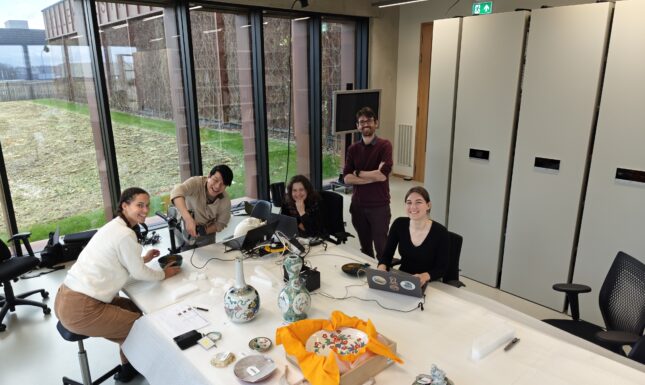

The equipment
We used two types of reflectance spectrometer equipment: a portable X-Ray Fluorescence (pXRF) device and a Fiber Optics Reflectance Spectroscopy (FORS) system of the Laboratory for Material Culture studies at Leiden. With the pXRF, the elemental composition of the enamels can be measured, while the FORS provides a UV-Visible light reflectance spectrum of the different coloured enamel decorations. Given the high value of the objects under study, it was important that the equipment we used was non-destructive.
First day of analysis: Ru-ware
The first day of analysis was centred around a single piece of Ru-ware porcelain. Despite its modest appearance, this porcelain bowl is a one-of-a-kind. Ru-ware was exclusively manufactured for Chinese emperors for only twenty years during the Northern Song dynasty (960-1127 CE). It is characterised by its iconic bluish-green colour, once described as ‘’the colour of the sky after a rainstorm”. Today, fewer than a hundred complete pieces of this porcelain type survive, with this bowl being the only piece of Ru-ware in the Netherlands. This makes Ru-ware the rarest and highly priced Chinese ceramic.
It is a rare occasion that this bowl is taken outside its display case, and the first time that it underwent compositional analysis, therefore warranting a visit from curators from across the country to see us perform the measurements. The bowl was analysed with the pXRF under various settings in order to identify as many chemical elements as possible, even connecting a helium tank to the measuring device to better identify lighter chemical elements.

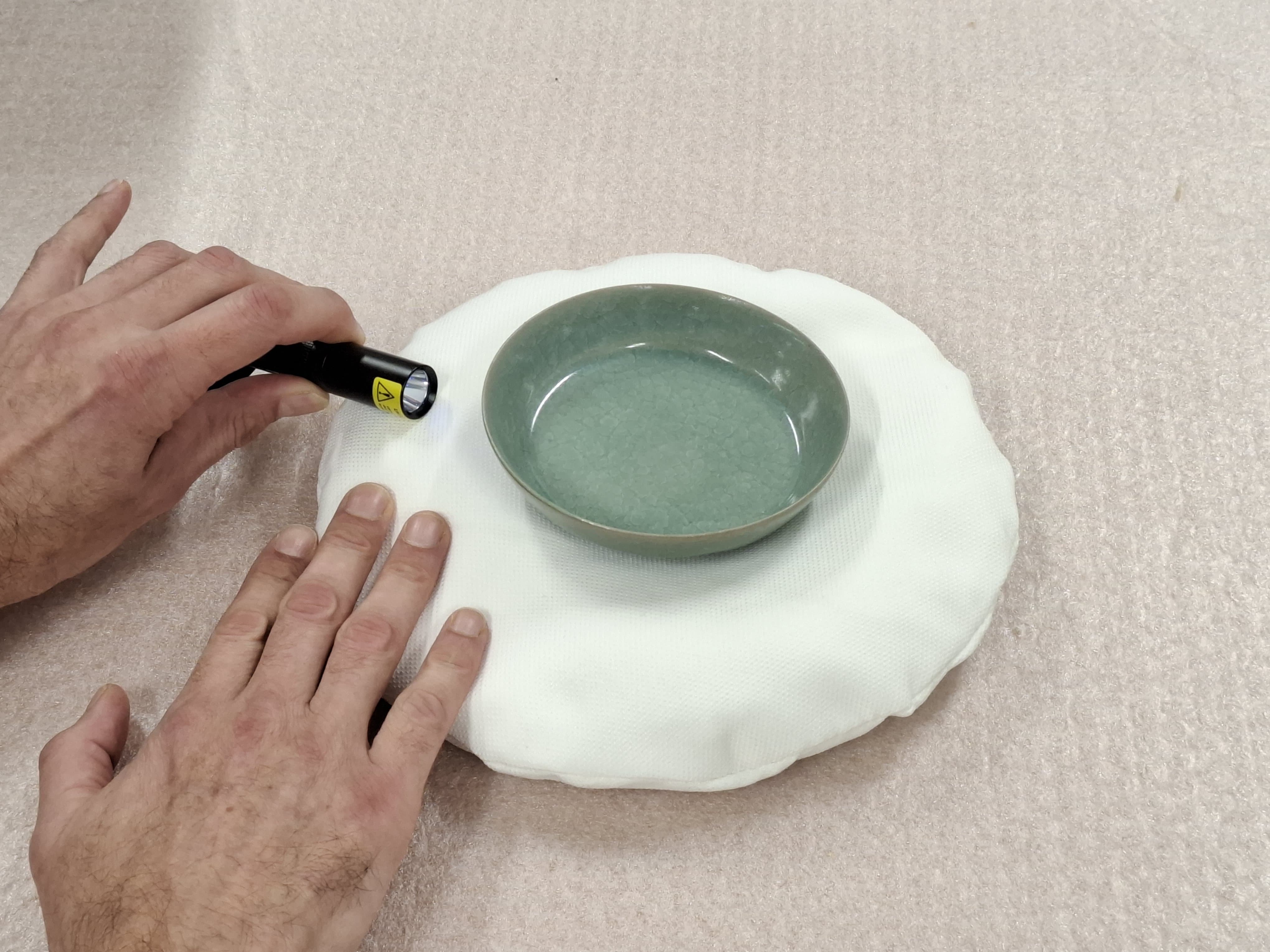
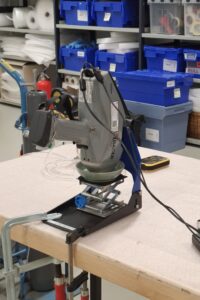

Second day of analysis: Ruby-back, Famille Verte, Famille Noir, Kakiemon, Kutani ware
On the second day we broadened our spectrum, leaving the precious Ru-ware behind and shifting our focus onto other types of Chinese and Japanese enamels. Continuing with FORS and pXRF analysis we looked at Japanese Kakiemon and Kutani wares and Chinese ruby-backs, famille vert and famille noir objects. The Chinese porcelains belonging to the different familles, are of the Qing Dynasty (1644–1912 CE) and, with some of the most extraordinary pieces designated for the imperial court, many of them were produced specifically for export to the West. The Japanese wares belong to traditions which lay at the beginnings of Japanese enamel porcelain production, ar. 16th/17th century, being more local in their technologies than the centrally controlled Chinese wares. Alongside the major Asian and European porcelains project, the Kutani wares were measured as part of an on-going research master study by Agnieszka Gawin that is looking both into the developing technology of these enamels and into perception-symbolism dynamic of the specific used colours, while the Kakiemon porcelain was analysed by Daniel Chen for his current PhD research project.
The variety of different colours making up the meticulously detailed decorations was exceptional. The raspberry ruby’s of the rubybacks, vibrant reds of the Kakiemon pieces or deep purples of Kutani provided a wide spectrum of varying shades to analyse, allowing to consider the changing pigment recipes in many colourful directions.
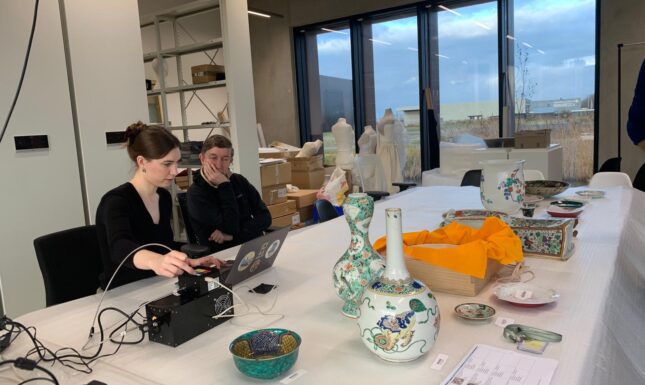

Looking back
The excitement of everyone in the room during the two days of the analysis was very clear. Apart from the research hopes, which were the backbone of our visit, the beautiful craftsmanship of these colourful enamels, in their precious rarity, made the trip, next to scientifically successful, artistically intriguing.
All of the measurements done, with both pXRF and FORS, are crucial building blocks in the expansion of a reference database for porcelain analysis, hopefully aiding in more reliable attributions, and providing reference data for detecting forgeries circling in the art market. The use of the non-destructive compositional equipment itself provided insights into the possibilities and capabilities of employing those methods when studying so highly valued porcelain enamels.
The study of Chinese and Japanese enamelled decorations is also an interesting meeting point of two very different, but deeply intertwined areas of study - exact scientific analysis and humanist art history. In the balancing nature of our study as interdisciplinary archaeological scientists, the possibility to interweave both sides, integrating these somewhat opposite points through our twofold proficiency leads to interesting results. These diverse perspectives curiously often link together, ‘shaking-hands’ on matters of authenticity and (intentional) colour manipulation.





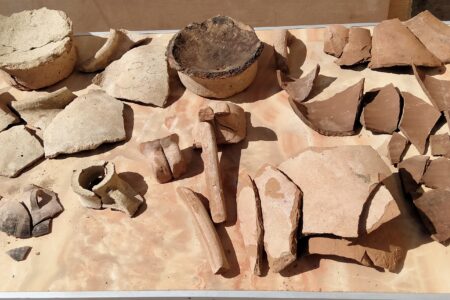
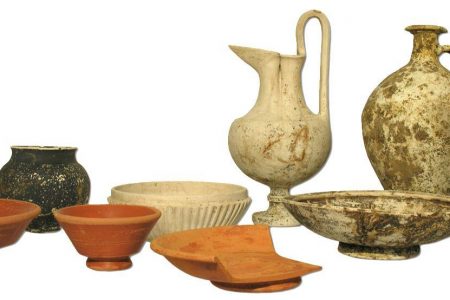
0 Comments